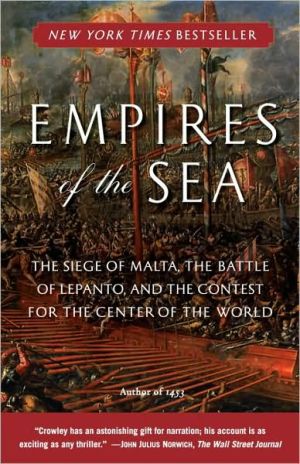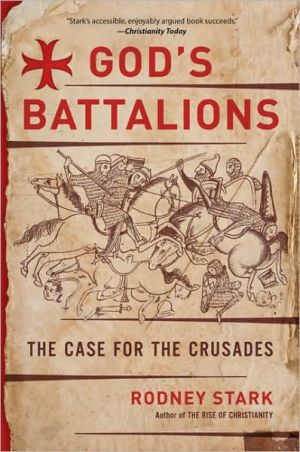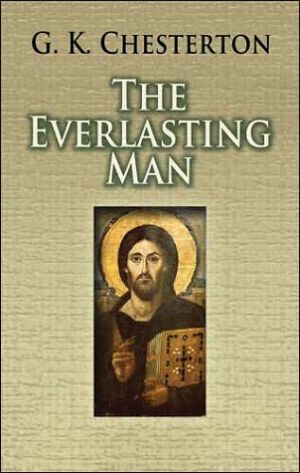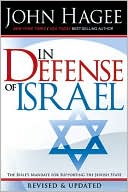Empires of the Sea: The Siege of Malta, the Battle of Lepanto, and the Contest for the Center of the World
Roger Crowley conjures up a wild cast of pirates, crusaders, and religious warriors struggling for supremacy and survival in a tale of slavery and galley warfare, desperate bravery and utter brutality, technology and Inca gold. Empires of the Sea is page-turning narrative history at its best - a story of extraordinary color and incident, rich in detail, full of surprises, and backed by a wealth of eyewitness accounts. It provides a crucial context for our own clash of civilizations.
Search in google:
Set during the height of the Ottoman Empire and with Christendom weakened and vulnerable, this is the story of the fifty-year battle for domination of the Mediterranean, centered around the titanic battles of Rhodes, Malta, and Lepanto—-three of the most dramatic and decisive battles in world history. The Barnes & Noble Review Europe has witnessed some bitter conflicts in its time, but for sheer savagery and blind religious fervour, few can match the 16th-century struggle for the mastery of the Mediterranean between the Ottoman Turks and the loose association of Christian states sheltering under the Hapsburg flag. For nearly 60 years, between 1521 and 1580, these two implacable enemies, fired by the certainty of their spiritual calling and driven by the absolute otherness of their foes, slugged it out for strategic supremacy of the sea, matching atrocity with atrocity as they searched for the blow that would floor their opponent.
Chapter One\ The Sultan Pays a Visit\ \ 1521–1523\ 10 September 1521, from Belgrade\ First the drumroll of imperial titles. Then the threat:\ Suleiman the sultan, by the grace of God, king of kings, sovereign of sovereigns, most high emperor of Byzantium and Trebizond, very powerful king of Persia, of Arabia, of Syria, and of Egypt, supreme lord of Europe, and of Asia, prince of Mecca and Aleppo, lord of Jerusalem, and ruler of the universal sea, to Philip de L’Isle Adam, Grand Master of the island of Rhodes, greetings.\ I congratulate you upon your new dignity, and upon your arrival within your territories. I trust that you will rule there prosperously, and with even more glory than your predecessors. I also mean to cultivate your favour. Rejoice then with me, as a very dear friend, that following in the footsteps of my father, who conquered Persia, Jerusalem, Arabia and Egypt, I have captured that most powerful of fortresses, Belgrade, during the late Autumn. After which, having offered battle to the Infidel, which they had not the courage to accept, I took many other beautiful and well-fortified cities, and destroyed most of their inhabitants either by sword or fire, the remainder being reduced to slavery. Now after sending my numerous and victorious army into their winter quarters, I shall myself return in triumph to my court at Constantinople.\ To those who could read between the lines this was not an expression of friendship. It was a declaration of war. Suleiman, great-grandson of Mehmet the Conqueror, had just inherited the Ottoman throne. According to custom and tradition, he was obliged to mark his accession with victories; each new sultan had to legitimize his position as “Conqueror of the Lands of the Orient and the Occident” by adding fresh territories to the world empire. He could then distribute booty, secure the loyalty of the army, and indulge in the ritual forms of propaganda. Victory letters—assertions of imperial power—were sent out to impress the Muslim world and intimidate the Christian one, and the new sultan could then start building his mosque.\ An accession also had to be accompanied by death. The sultan was required by law to kill all his brothers “in the interest of the world order,” to scotch the possibility of civil war. A mournful line of children’s coffins would be carried out of the palace harem to the muted sobbing of women, while stranglers with bowstrings were dispatched to distant provinces to hunt down older siblings.\ In Suleiman’s case there were no such deaths. He was the sole male heir. It is likely that his father, Selim, had executed all his other sons six years earlier to snuff out preemptive coups. The twenty-six- year-old was uniquely blessed in his inheritance. He acquired a powerful, unified empire possessed of unrivaled resources. To pious Muslims, Suleiman was the harbinger of good fortune. His name—Solomon— chosen by opening the Koran at random, presaged a ruler dedicated to wisdom and justice. In an age of portents, all the circumstances of Suleiman’s accession were significant. He was the tenth sultan, born in the tenth year of the tenth century of the Muslim era. Ten was the cipher of perfection: the number of the parts of the Koran, the number of disciples of the Prophet, the commandments in the Pentateuch, and the astrological heavens of Islam. And Suleiman stepped onto the world stage at a moment of imperial destiny.\ His reign would overlap and compete with the claims of a jostling crowd of rival monarchs: the Hapsburgs, Charles V and Philip II of Spain; the French Valois kings, Francis I and his son Henry II; in England the Tudors, Henry VIII and Elizabeth I; in Muscovy, Ivan the Terrible; in Iran, Shah Ismail; in India, the Mogul emperor Akbar. None would have a keener sense of imperial mission or make for themselves more lofty claims.\ From the start Suleiman made a powerful and calculated impression on the foreign ambassadors admitted to his court. “The sultan is tall and slender but tough, with a thin and wiry face,” wrote the Venetian Bartolomeo Contarini. “Rumour has it that Suleiman is aptly named . . . is knowledgeable and shows good judgement.” His countenance was sober, his gaze steady, his caftans simple but magnificent. His height and physical presence were enhanced by the size of the enormous spherical turban pulled low over his forehead, and by his pale face. He meant to impress with the splendor of his person and his court. Soon he would lay claim to the title of Caesar and envisage control of the Mediterranean.\ He had two immediate victories in mind. Keenly aware of the achievements of his forebears, Suleiman had dreamed, since boyhood, of completing the twin conquests that had eluded his great- grandfather Mehmet. The first was the storming of the fortress of Belgrade, the gateway to Hungary. Within ten months of his accession, the sultan was encamped before the city walls; by August 1521 he was saying prayers in its Christian cathedral. The second conquest was intended to advance his claim to be “Padishah of the White Sea.” It was to be the capture of Rhodes.\ the island to which Suleiman now turned his attention was a strange anachronism—a freak Christian survivor from the medieval Crusades located within touching distance of the Islamic world. Rhodes is the most substantial and fertile of a belt of limestone islands—the Dodecanese, the twelve islands—that stretches for a hundred miles along the coast of Asia Minor. Rhodes lies at the southwest end of the group; the northern marker is the whitewashed monastery island of Patmos, one of Orthodox Christianity’s holy sites, where Saint John the Divine received the revelations of the New Testament. These islands are so closely intertwined with the bays and headlands of the Asian shore that the mainland is always a presence on the horizon. From Rhodes the crossing is a bare eleven miles, just a couple of hours’ sailing time with a smart wind, so near that on clear winter days the snowy Asian mountains, refracted through the thin air, seem almost within touching distance.\ When Mehmet took Constantinople in 1453, Christian powers still held the whole of the Aegean Sea in a defensive ring, like an arch whose strength depended on the interdependence of each stone. By 1521, the entire structure had collapsed; yet against gravity, Rhodes, the keystone, survived as an isolated Christian bastion that menaced the Ottomans’ sea-lanes and cramped their maritime ambitions.\ Rhodes and its accompanying islands were held in the name of the pope by the last remnant of the great military orders of the Crusades, the Knights of Saint John—the Hospitallers—whose fortunes closely mirrored the whole crusading enterprise. Originally founded to provide care for sick pilgrims in Jerusalem, they had also become, like the Templars and the Teutonic Knights, a military fighting order. Its members took lifelong vows of poverty, chastity, and obedience to the pope; their cardinal purpose was to wage unceasing war on the infidel. The Order of Saint John had fought in every significant action in the long wars of the Holy Land until they were cut down, almost to a man, with their backs to the sea at Acre in May 1291. In exile they searched for a means to continue this struggle, and their eyes alighted on the Greek Christian island of Rhodes. In 1307 they attacked and captured it. Rhodes became Western Christendom’s deep position against the Islamic world, a launchpad from which a new counteroffensive for Palestine could be prepared at some point in the unspecified future.\ In the town of Rhodes the knights created a small feudal bastion, a last outpost of the Latin Crusades, subject only to the pope, paid for from the rents on the Order’s huge land holdings in Europe, and dedicated to holy war. The Holy Religion, as the knights called themselves, understood fortified places; they had generations of experience of frontier defense in Palestine. They had constructed Crac des Chevaliers, the greatest of the Crusader castles, and they now fortified the town with bravado and reinvented themselves as sea raiders, building and equipping a small squadron of heavily armed galleys, with which they plundered the Ottoman coasts and sea-lanes, taking slaves and booty.\ For two hundred years, the Hospitallers maintained an uncompromising piratical presence on the edge of the Muslim world, holding\ the Dodecanese as a chain of fortified islands to pen in the Turks. The knights even managed to keep a toehold on the mainland itself, at the fortress the Turks called Bodrum—the castle of Saint Peter the Liberator. The fortress served both as an escape route for Christian slaves and as a propaganda tool for raising funds for the Order’s mission throughout Europe. The knights, well aware of the fate that had befallen the Templars, managed their image carefully as the Shield of Christendom.\ European opinion of the knights was mixed. For the Papacy, Rhodes carried a huge symbolic weight as the outer line of defense against the infidel, manning a maritime frontier in continual contraction as the Byzantine inheritance crumbled before the Islamic advance and one\ by one the bright ring of islands fell to the Ottomans. Pope Pius II lamented that “if all the other Christian princes . . . had shown themselves as tireless in their hostility to the Turks as the single island of Rhodes had done, that impious people would not have grown so strong.” Even after the fall of Constantinople, Rhodes continued to nourish the Holy See’s most cherished project—the possibility of an eventual return to the Holy Land. Others were less charitable: to Christian maritime traders, the Hospitallers were a dangerous anachronism. The Order’s acts of piracy and blockades of Western trade with Muslims threatened to destabilize the delicate peace on which commerce depended. The Venetians thought the knights indistinguishable from corsairs and regarded them as a menace second only to Ottoman imperial ambitions.\ The knights’ impact certainly outstripped their resources. There were never more than five hundred on Rhodes, drawn from the aristocracy of Europe, supported more or less willingly by the local Greek population and mercenaries. They comprised a small well-organized military elite with a powerful sense of mission whose nuisance value was out of proportion to their number. Their galleys lurked in the aquamarine lagoons and rocky inlets of the Asian shore, quick to snatch passing traffic—boatloads of pilgrims from Istanbul bound for Mecca; timber for Egypt from the Black Sea; cargoes of spices from Arabia; honey, dried fish, wine, and silk. Their reputation was fearsome among friend and foe alike. To tackle a Hospitaller galley was to take on a scorpion. “These corsairs are noted for their energy and daring,” wrote the Ottoman chroniclers. “They disrupt life, causing all sorts of losses to merchants, and capturing travelers.” To Muslims, they were, and always had been, the archenemy, the “evil sect of Franks, the worst sons of Error, the most corrupted of the Devil’s spawn”; the Muslim general Saladin had slaughtered his Hospitaller captives without compunction during the Crusades. Their allegiance to the pope made them doubly loathsome in Ottoman eyes. Worse still, they ran a market on the island for the sale of Muslim slaves. “How many sons of the Prophet are captured by these children of lies?” mourned the Muslim chroniclers. “How many thousand of the faithful are forced to turn infidel? How many wives and children? Their wickedness knows no end.”\ Successive sultans perceived Rhodes as a menace, an affront to sovereignty—and unfinished business. Mehmet had sent a large invasion force to take it and been humiliated. When Selim, Suleiman’s father, captured Egypt in 1517, the position of Rhodes astride the sea route to Istanbul increased the island’s strategic threat. The early decades of the sixteenth century were a time of hunger in the Eastern Mediterranean, and food supplies for the capital were critical. “The said Rhodians are inflicting great losses on the sultan’s subjects,” noted the Venetian diarist Sanudo in 1512, the year the knights captured eighteen grain transports bound for Istanbul and forced up the prices there by 50 percent. Complaints to the sultan grew audible: “They don’t let the ships of merchants or pilgrims bound for Egypt pass without sinking them with their cannon and capturing the Muslims.” To Suleiman this was not just a strategic threat; his position as “head of Muhammad’s community” was at stake. The taking of Muslim slaves on the very doorstep of his realm was intolerable. He now decided to crush “the vipers’ nest of Franks.”\ nine days after suleiman had written his victory letter in Belgrade, the man to whom it was addressed set foot in Rhodes. His name was Philippe Villiers de L’Isle Adam, a French aristocrat who had just been elected grand master of the Order of Saint John. He was fifty- seven years old, the descendant of a family with a long history of dying for the Crusades. His ancestor had conducted the order’s last- ditch defense at Acre in 1291. L’Isle Adam must have been under few illusions about the task ahead. The voyage from Marseilles to take up his post had been ominous with portents. Off Nice, one of his vessels caught fire; in the Malta Channel, the Order’s great flagship, the Saint Mary, was blasted by a lightning bolt. Nine men fell dead; a crackle of electricity flashed down the grand master’s sword, reducing it to twisted scrap, but he stepped away from the scorched deck unharmed. When the ships put in at Syracuse to repair the storm damage, they found themselves shadowed by the Turkish corsair Kurtoglu, cruising offshore with a powerful squadron of galleys stripped for war. Under cover of darkness, the knights quietly slipped from the harbor and outran their pursuers on a westerly wind.\ When he read Suleiman’s letter, L’Isle Adam framed a terse response, distinctly short of pleasantries and any recognition of the sultan’s grander titles. “Brother Philippe Villiers de L’Isle Adam, Grand Master of Rhodes, to Suleiman, sultan of the Turks,” it began. “I have right well comprehended the meaning of your letter, which has been presented to me by your ambassador.” The grand master went on to recount the attempt by Kurtoglu to capture the ship on which he was traveling, before concluding with an abrupt “Farewell.” At the same time, he dispatched a parallel letter to the king of France: “Sire, since he became Grand Turk, this is the first letter that he has sent to Rhodes, and we do not accept it as a token of friendship, but rather as a veiled threat.”
Prologue: Ptolemy's MapMap: The Mediterranean c. 1560Map: The Siege of MaltaMap: The Battle of LepantoPt. 1 Caesars: The Contest for the SeaCh. 1 The Sultan Pays a Visit 3Ch. 2 A Supplication 23Ch. 3 The King of Evil 34Ch. 4 The Voyage to Tunis 44Ch. 5 Doria and Barbarossa 57Ch. 6 The Turkish Sea 66Pt. 2 Epicenter: The Battle for MaltaCh. 7 Nest of Vipers 85Ch. 8 Invasion Fleet 98Ch. 9 The Post of Death 109Ch. 10 The Ravelin of Europe 123Ch. 11 The Last Swimmers 135Ch. 12 Payback 142Ch. 13 Trench Wars 156Ch. 14 "Malta Yok" 173Pt. 3 Endgame: Hurtling to LepantoCh. 15 The Pope's Dream 191Ch. 16 A Head in a Dish 204Ch. 17 Famagusta 221Ch. 18 Christ's General 231Ch. 19 Snakes to a Charm 242Ch. 20 "Let's Fight" 255Ch. 21 Sea of Fire 266Ch. 22 Other Oceans 278Epilogue: Traces 289Author's Note and Acknowledgments 293Source Notes 297Bibliography 311Index 317
\ Publishers WeeklyCrowley (1453), an independent scholar of the 16th-century Mediterranean, focuses here on the final contest between Christian and Muslim, Hapsburg and Ottoman, for control of the Middle Sea. Masterfully synthesizing primary and secondary sources, he vividly reconstructs the great battles, Malta and Lepanto, that shaped the struggle and introduces the larger-than-life personalities that dominated council chambers and fields of battle. This was a time of hard men who took high risks, asked no mercy and gave no quarter. Familiar figures like Philip II of Spain and Suleiman the Magnificent share the stage with Jean de La Valette, whose inspired defense of Malta in 1565 checked a tide of Ottoman victories, and the great corsair Hayrettin Barbarossa. Crowley recreates the fighting and the brutality in page-turning prose that never sacrifices accuracy for color. He also demonstrates that the conflict, which ended with a compromise peace in 1580, marked the Mediterranean basin's end as the center of the world. Henceforth the loci of power would shift elsewhere in a modernizing world. Illus. (July 1)\ Copyright © Reed Business Information, a division of Reed Elsevier Inc. All rights reserved.\ \ \ \ \ Kirkus ReviewsExciting re-creation of the epic mid-16th-century struggle between the encroaching Ottoman Empire and the beleaguered Christian Europeans. Crowley picks up where he left off in 1453: The Holy War for Constantinople and the Clash of Islam and the West (2005). After the fall of Constantinople to Mehmet the Conqueror and his army of Turks, the author writes, it was only a matter of time before Mehmet's great-grandson Suleiman set out to achieve his own ambition to become "Padishah of the White Sea"-the Mediterranean. From the 1520s on, Suleiman and later his son Selim II clashed repeatedly with Charles V and then Philip II of Spain in a battle for holy ascendancy that stretched from Rhodes to Tunis, Cyprus to Lepanto. Suleiman unleashed his murderous corsairs, led by the Barbarossa brothers, to wreak havoc on the Barbary Coast (North Africa), while Charles employed the astute services of the valiant Genoese sea commander Andrea Doria. Radiating from Madrid and Istanbul across Europe, the engines of imperial power collided catastrophically in 1565 on the rugged island of Malta, a launch pad for the crusading Knights of Saint John headed by the zealous Jean Parisot de La Valette. Here Crowley lingers with chillingly detailed precision, depicting the armada of Turkish galleys bearing down on the island. Seventy-year-old La Valette and his 6,000 or so fighting men hastily prepared for defense against an Ottoman force exceeding 20,000. The Knights and the rest of Europe were convinced that this was the final redoubt, "the glorious last-ditch stand against impossible odds, massacre, martyrdom, and death." What ensued was a four-month bloodbath, with the Christians routing the Turks and checkingtheir advance into the White Sea. A masterly narrative that captures the religious fervor, brutality and mayhem of this intensive contest for the "center of the world."Agent: Andrew Lownie/Andrew Lownie Literary Agency\ \ \ From the Publisher"A masterly narrative that captures the religious fervor, brutality and mayhem of this intensive contest for the 'center of the world.'" —-Kirkus Starred Review\ \ \ \ \ The Barnes & Noble ReviewEurope has witnessed some bitter conflicts in its time, but for sheer savagery and blind religious fervour, few can match the 16th-century struggle for the mastery of the Mediterranean between the Ottoman Turks and the loose association of Christian states sheltering under the Hapsburg flag. For nearly 60 years, between 1521 and 1580, these two implacable enemies, fired by the certainty of their spiritual calling and driven by the absolute otherness of their foes, slugged it out for strategic supremacy of the sea, matching atrocity with atrocity as they searched for the blow that would floor their opponent. \ It was a war of often chaotic cut-and-thrust, vicious raids, and the occasional set-piece battle whose reverberations, Roger Crowley points out in this engrossing history, reached halfway round the world. The Spanish funded their galleys with bullion plundered from the treasure houses of the New World, while the Ottomans filled their fleets with soldiers, sailors, and slaves plucked from every corner of Mediterranean Europe, North Africa and the Near East. It might be stretching a point to call this naval contest a "world war," as Crowley does in his prologue, but the struggle was epic, and the outcome fixed many of the lines along which Christianity and Islam still divide today.\ Crowley, a British publisher turned historian, proved with his first book, 1453: The Holy War for Constantinople and the Clash of Islam and the West, what a gifted narrative historian he is, and he demonstrates it again in this lively and dramatic tale. Sitting at opposite ends of the Mediterranean, both major participants in the war -- the Ottomans under Suleiman the Magnificent and then Selim II, the Spanish Hapsburgs under Charles V and Philip II -- saw themselves as imperial heirs to the Romans. "One empire, one faith, and one sovereignty in the world" was the rallying call of the sultans, but it might as well have been the battle cry of the Hapsburgs, who were happy to present themselves as the secular champions of Catholic Europe against all Muslims and heretics.\ Charles and Philip's bold conviction about their destiny didn't help, however, when it came to actually prosecuting the war. For most of the 60-odd years of naval conflict, Christian Europe found itself hopelessly on the defensive, its ships outmaneuvered, its commanders outwitted, its fleets outmuscled. Year after year, Ottoman galleys rampaged up and down the Mediterranean coastline, sacking towns, slaughtering civilians, and taking thousands of Christians into slavery. Commanders such as the fearsome Hayrettin Barbarossa, whom the Spanish dubbed "the king of evil," or the chillingly named Ayret the Devil Hunter, became figures of terror around Europe, monsters for mothers to threaten naughty children with, and they played up to their reputations with campaigns of deliberate and bloody intimidation. In 1544, in one of countless acts of barbarism during that season's campaigning, Barbarossa had the body of the recently deceased leader of the Italian coastal town of Talamona "ripped from its tomb, ritually disemboweled, chopped into pieces and burned in the public square, along with the corpses of his officers and servants." When the islanders of Lipari tried to buy their way out of trouble, Barbarossa took their money, enslaved them all anyway, then "out of spite" slaughtered several terrified old people who had been found sheltering in the cathedral . "The very mention of the Turks," remarked a French priest called Jerome Maurand, who witnessed Babarossa's bloodthirsty rampage that year, "is so horrifying and terrible to the Christians that it makes them lose not only their strength but also their wits."\ The Hapsburgs, when they got the opportunity, could be just as brutal and just as ruthless. When Charles V took Tunis in 1535, thousands of surrendering Muslims were simply cut down in the street, their houses razed, and their mosques sacked. Tens of thousands more were sold into slavery. In Majorca, the locals celebrating Charles's victory dressed up a local criminal to look like Barbarossa, cut out his tongue, and burned him alive, all to vengeful whoops of joy.\ Such opportunities for grisly festivities, though, were few and far between. Until the decisive Battle of Lepanto in 1571, which effectively brought a halt to Ottoman expansion in the Mediterranean (and which provides a suitably titanic climax to Crowley's book), the Spanish and their allies had little to boast of by way of victories. Part of the problem was the West's fatal lack of unity. Mutual distrust and divergent interests meant that Venice, Spain, and the Papacy, the Turks' main opponents, seldom agreed on strategy and were rarely willing to sacrifice either men or ships for their supposed allies. At the catastrophic Battle of Preveza in 1538, which opened up much of the Mediterranean to the Ottomans for several decades, the Genoese galleys of Andrea Doria first held back when the Venetians plunged forward to attack, and then, with the battle going badly, turned tail, extinguished their stern lanterns, and slunk off quietly into the night. The Venetians took a long time to forgive, forget, and indeed recover militarily.\ All this dissension in Christian ranks meant that, for much of the time, the main resistance to Ottoman expansion came from the Knights of St John, a small but zealously committed band of Hospitaler soldiers who were the last remnant of the old Latin crusading tradition. First at Rhodes in 1521, and then and most spectacularly at the desperate and viciously fought siege of Malta in 1565, these desperately outnumbered knights, confronted by vast swathes of Ottoman soldiery, sacrificed body and soul for the cause of Christianity. "I don't know if the image of hell can describe the appalling battle," wrote the chronicler Giacomo Bosio of one particularly frenzied battle during the siege of Malta; "the fire, the heat, the continuous flames from the flame throwers and fire hoops; the thick smoke, the stench, the disemboweled and mutilated corpses, the clash of arms, the groans, shouts and cries, the roar of the guns...men wounding, killing, scrabbling, throwing each other back, falling and firing."\ Crowley recounts these two remarkable clashes, a gift for any historian, with real élan. He is particularly skilful at following the thread of a battle and in illuminating events with deft and fragrant phrases. Nowhere does he pretend to open up scholarly new ground on the subject, but without ever drawing any heavy-handed, "Clash of Civilizations"–like parallels between then and now, he re-animates thrillingly, in the very best old-fashioned narrative tradition, these partially forgotten struggles, the consequences of which we are all still living with today. -- Andrew Holgate\ Andrew Holgate is Deputy Literary Editor for The Sunday Times (London).\ \ \








